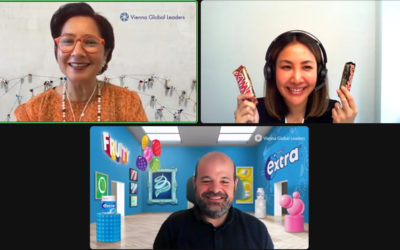How to Develop a Corporate Culture of Helping? From Givers, Takers & Matchers
Stefan Teufl
19 May 2020 | VGL Insights

“….With a little help from my friend!” This is what Joe Cocker sang in a song in the 1970s that has since become famous.
Are you currently also observing that many people want to help? Be it a football club that supports the Red Cross, students who get involved in health hotlines such as the Austrian “1450”, or young people in residential buildings who support the elderly with errands. According to a recent report by the New York Times, people coping best with the crisis are those who help others (“To help yourself, start by helping others!”).
But why do people help? Psychologist Adam Grant dedicated himself to this question in his research and found that the individual success parameters such as hard work, passion and talent are no longer the only decisive factors today. He states that “success” depends more on how we deal with others. When interacting with others, he differentiates between three basic types:
- “Takers” are people who focus their actions exclusively on their own advantage and success.
- “Matchers” like to help other people. However, they make sure that they get something in return at some point. Matchers strive for a long-term balance of give and take, according to the motto of “one hand washes the other“. This leads to the danger — albeit a natural tendency — that people in organizations tend to drift into “negative spirals”. Because of unconscious biases, they pay more attention to what they don’t get from others than to what they are not willing to give themselves. This drives people to wait for others to take the first step, which creates a culture of “holding back” instead of getting involved proactively and with positive energy.
- “Givers” are those who fully help others and are characterized by honesty and empathy. They want to get the best possible result for everyone without expecting anything in return. Givers act generously, as a sign of social intelligence. They maintain an “ethics of gift”, in which giving is not devalued by calculating the benefits.
What is a culture of helping in a corporate context?
Helping seems obvious, but how do you implement a “culture of helping” professionally and what suggestions are there for leaders? Here, Edgar H. Schein sheds light on this.
He is concerned with questions about the basic rules of a helping relationship, the meaning and impact of building relationships and with trust in social dynamics between the helper and the client.
To promote open and trusting communication with one another, he takes a special look at relationship building in his (by the way, outstanding) book Helping. Here, he differentiates two types of relationships that build on one another:
- In social interaction, we are used to cultivating a formal relationship that is characteristic of most helping situations, such as relationships between doctors and patients or consultants and clients. Schein refers to such a fundamentally professional relationship between actors as a “Level 1 relationship“.
- However, you can further deepen a formal-professional relationship by showing caring interest for others in their situations and thereby get involved in helping. This creates a “Level 2 relationship” that enables open and trusting communication.
Building a “Level 2 working relationship” requires that you personalize your relationship in the moment of personal or virtual contact by conveying an attitude which is characterized by:
- Commitment to help
- Curiosity
- Caring for the employees and their current situation (e.g. duty of care of the employer according to the Austrian employee protection law “ASchG”)
Suggestions and Action Tips for („Level-2“) Leaders
- Pay special attention in your teams to, who needs more proximity vs. who needs more distance.
- Invest particularly in maintaining relationships and ask out of sincere interest how everyone is doing instead of only explaining what they should do. This means currently avoid a “culture of doing and telling”
- The fundamental “helping skill” of a leader, according to Mr. Schein, is the technique of “humble inquiry”. By doing so, you choose the ideal way to build a sustainable and trusting working relationship.
- Questions are therefore the most important means of helping efficiently (“Who asks, leads“)
- Ask interested and personal questions
- Show empathy for your counterparts as well as their emotions about the current situation (“their emotional fever curve in times of changes“)
- Share your own and personal thoughts and experiences
- Encourage your team members to continue talking, “Please tell me more …”, “What triggered that in you…”
- In this way, you support the promotion of a culture of helping in your teams: everyone is both a helper and a client right now!
This “gentle art of asking instead of telling” is a process that requires a lot of practice and courage from a leader, but how the aforementioned Joe Cocker sang: „Have a little faith in you!“…
References:
GRANT Adam (2013): Give & Take. Why helping others drives our success. Penguin NY
SCHEIN Edgar (2009): Helping. How to offer, give and receive help. Berret-Koehler
SCHEIN Edgar, SHOOK John (2017): On Coaching. Lean Enterprise Institute
PARKER-POPE Tara (2020): The science of helping out. NYT, 09 April 2020
ROSE Niko (2019): Sonnen und schwarze Löcher in der Organisation. In: ZOE 3/2019
Additional Links/Videos:
Adam Grant (Youtube): Are you a giver or a taker?Edgar Schein (Heart of the Art): Ed Schein´s Principles of Helping
The German version of this blog was originally published on 17 April 2020 on TeuflsBlog.com
VGL Forum
Join our virtual VGL Forum, an open space online to discuss leadership issues with experts, share solutions and enhance leadership skills across industries.

Stefan is Co-Head of a Corporate Academy in a bank and acts as Vice President for Learning & Development. He is particularly interested in new ways of digital working, creating cultures of lifelong learning and positive leadership. He is volunteering as reviewer for an OD-journal and as lecturer at Vienna University of Economics and Business. He has been awarded as Speaker of the year 2017 from imh Vienna. Just recently he started successfully his private blog-series on “Meaning & Emotions in Organizations” (teuflsblog.com). LinkedIn | Twitter

Stefan is Co-Head of a Corporate Academy in a bank and acts as Vice President for Learning & Development. He is particularly interested in new ways of digital working, creating cultures of lifelong learning and positive leadership. He is volunteering as reviewer for an OD-journal and as lecturer at Vienna University of Economics and Business. He has been awarded as Speaker of the year 2017 from imh Vienna. Just recently he started successfully his private blog-series on “Meaning & Emotions in Organizations”(teuflsblog.com). LinkedIn | Twitter
Recent Posts
Recording: VGL Forum – What does it mean to be an extraordinary leader?
Watch the recording of “What does it mean to be an extraordinary leader?”
Recording: VGL Forum – Ukraine Crisis, the Limitations of International Law and Our Responsibility
Watch the recording of Ukraine Crisis, the Limitations of International Law and Our Responsibility.
Recording: VGL Forum – Hard Truths on Leadership Transitions
Watch the recording of the VGL Forum on Hard Truths on Leadership Transitions, featuring the stories of three leaders.
Stay updated with VGL Forums and workshops!

Vienna Global Leaders is a platform by EUNEPA dedicated to developing and connecting managers and leaders in a complex world.
Vienna Global Leaders by EUNEPA
Wiedner Hauptstrasse 142 / Top 5, 1050 Vienna, Austria
T: +43 1 996 2078
E: info@viennagloballeaders.com



0 Comments